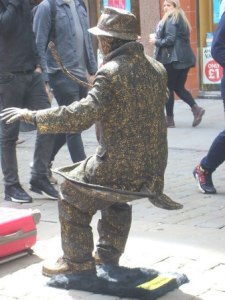Flowers & Shoes: Why I’ve Always Got Two Projects On The Go (Pete Kalu)
While researching literary approaches to consciousness and time, I came across an article by Burkhard Bilger on David Eagleman, the neuroscientist interested in the nature of time.* Eagleman, a modern-day horologist, has been interested in how time slows in moments of danger or crisis – ever since he fell off a roof at eight years old and noticed the phenomenon.
Much of his work has been trying to find and analyse biological clocks. Apparently, a few have been pretty much located: the circadian clock in the hypothalamus tracks night and day; the cerebellum tracks muscle movement and works in seconds or minutes; the bits of grey matter called the basal ganglia also deal with time though scientists are not yet sure quite how. Time. Could neurons which “pulse” – neurotransmitters – also have a role? Is our sense of time something that hangs onto the coattails of our other senses- as Bilger puts it, is it metasensory?
The Bilger article covers how Eagleman has done experiments ranging from the bizarre to the plain crazy to test hypotheses. One of the most fascinating points Eagleman makes is that the senses work at different speeds, that all sensory information is processed by the brain to form a kind of unified theory of reality; and that there is a processing lag while this happens. So our perception of something is always milliseconds behind the event itself: we are all living in the perpetual past.
Another observation Eagleman makes is that when things become same-y, we stop storing them in memory. The reverse also applies. When things go skewiff, suddenly the brain, including memory, awakes, and time starts to stretch, recording goes HD. The amygdale is thought to be responsible for this occurrence. If the amygdale is the seat of emotion AND memory and kicks into overdrive when a threat is sensed, it could explain why some people remember these dangerous moments in great detail. I remember when my foot hit my car brakes while I was doing 70mph on the M62 motorway and there was no reaction. The brakes had failed. Among lots of other things, I recall marveling bizarrely at how much time I seemed to have to deal with the situation (I used the hand brake to slow the car and got it off the motorway – it was close run thing).
My favourite example of how time morphs, as related in the article, is the brown shoe- flower experiment that Eagleman cites. When shown a series of pictures of a shoe interrupted occasionally by a picture of a flower, observers thought the flower picture was shown for longer than the shoe picture. It wasn’t. We simply notice it more because of its novelty. A parallel experiment was done (somewhat involuntarily vis a vis the scientist Hoaglund’s flu-ridden wife, but since replicated) which appears to indicate that someone with ‘flu feels time ticking faster than someone without flu.
So, what’s all this got to do with writing a novel? Apart from the obvious implications for technique and description (in my novel there are a series of dangerous events when time slows in different ways), I feel it might explain why I’ve always got two writing projects on the go: Switching between projects defamiliarises the text, so allowing the shoe to become a flower.
* (see The New Yorker April 20111 http://www.newyorker.com/magazine/2011/04/25/the-possibilian )


0 Comments